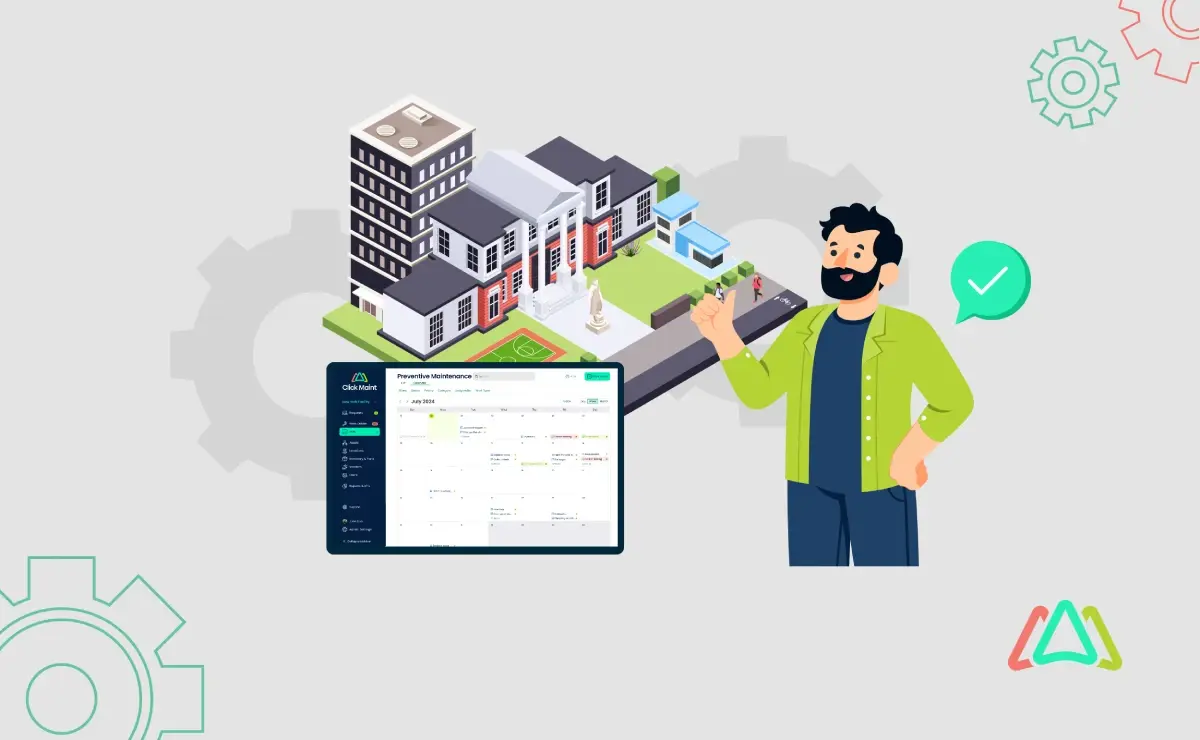
Managing Campus Infrastructure and Sustainability with CMMS in Universities
Introduction
Most of us have experienced campus life either as students or visitors, and we've likely noticed the challenges universities face in maintaining their infrastructure while ensuring long-term operational efficiency. In the face of growing enrollment numbers and aging facilities, universities are grappling with significant infrastructure challenges. Managing campus infrastructure and sustainability is vital for universities because it directly impacts the quality of education and the student experience. Effective infrastructure management ensures that facilities are safe, functional, and conducive to learning. On the sustainability front, universities have a unique role in leading by example, demonstrating innovative practices that other sectors and future generations can adopt. This article explores the critical role of CMMS in managing campus infrastructure and promoting sustainable operations in universities.
What is a CMMS?

A Computerized Maintenance Management System (CMMS) is software designed to streamline and enhance maintenance operations. Its core functions include scheduling, tracking, and managing maintenance activities to ensure that assets remain in optimal condition and fully operational. CMMS achieves this by integrating various components, such as a central database, user interface, and reporting tools, which together provide a comprehensive overview of maintenance activities. By seamlessly integrating with campus infrastructure, CMMS enables real-time monitoring and management of buildings, utilities, and equipment.
The benefits of CMMS software are extensive. It enhances maintenance management by automating task scheduling and tracking, reducing downtime, and prolonging the lifespan of assets through efficient asset lifecycle management. CMMS contributes to sustainable operations by monitoring energy usage and implementing efficient practices. Additionally, CMMS offers data-driven decision-making capabilities, providing detailed reports and analytics to support strategic planning and continuous improvement.
Benefits of CMMS in University Infrastructure Management
Streamlined Maintenance Processes
CMMS automates work order generation, assignment, and tracking, enabling facility managers to prioritize and monitor tasks in real-time. This ensures timely resolution of issues, minimizes disruptions to daily operations, and maintains a smooth campus environment.
Enhanced Resource Allocation
Universities operate within tight budgets and need efficient resource allocation. CMMS provides insights into resource utilization, enabling data-driven decisions. Whether allocating manpower or managing inventory levels, CMMS helps optimize resource allocation, ensuring that resources are used effectively and efficiently.
Improved Preventive Maintenance
Preventive maintenance is essential for minimizing equipment downtime and extending asset lifespan. CMMS leverages predictive analytics and historical data to schedule maintenance tasks proactively, saving time and resources while ensuring the longevity of facilities and equipment. This proactive approach prevents unexpected failures and costly repairs.
Compliance Management
Universities must adhere to various regulations and safety standards. CMMS simplifies compliance by automating documentation, scheduling inspections, and generating audit trails. This ensures adherence to standards, mitigates risks, and provides administrators with peace of mind, knowing that their campus meets all regulatory requirements.
Data-Driven Decision Making
CMMS offers comprehensive reporting and analytics tools, allowing facility managers to gain insights into maintenance operations. By analyzing data and performance metrics, universities can identify areas for improvement, effectively plan for future needs, and make informed decisions that support long-term sustainability and efficiency.
Enhancing Operational Efficiency

CMMS streamlines maintenance tasks by automating work orders, scheduling preventive maintenance, and tracking asset history. This automation leads to reduced downtime and improved operational efficiency, ensuring that campus facilities are always in optimal condition. The seamless operation of infrastructure supports uninterrupted academic and administrative activities.
Prolonging Asset Lifespan
Regular maintenance facilitated by CMMS helps in extending the lifespan of critical infrastructure components. By preventing breakdowns and costly repairs, universities can maximize their return on investment in facilities and equipment. This not only saves money but also ensures that the infrastructure continues to support the university’s operations effectively over time.
Cost Efficiency
CMMS contributes to significant cost savings by optimizing maintenance processes, reducing emergency repairs, and extending the lifespan of assets. Efficient resource management and reduced downtime translate into financial savings, allowing universities to allocate funds to other critical areas such as academic programs and student services.
Enhanced Communication and Collaboration
CMMS platforms often include communication tools that facilitate better collaboration among maintenance teams, faculty, and administrative staff. By centralizing communication, CMMS ensures that everyone is informed and on the same page, leading to quicker resolutions and a more cohesive approach to maintenance management.
Increased Accountability and Transparency
CMMS provides a transparent view of all maintenance activities, making it easier to track progress and hold teams accountable. Detailed records and audit trails enhance accountability, ensuring that maintenance tasks are completed as scheduled and to the required standards.
By adopting a maintenance management software, universities can improve their infrastructure management and achieve long-term sustainability, ensuring that their campuses remain conducive to learning and growth.
Campus Infrastructure and Sustainability

Campus infrastructure encompasses all physical assets essential for university operations, including buildings, utilities, transportation systems, and recreational facilities. These elements form the backbone of a university, supporting educational, administrative, and social activities. Sustainability in the context of university infrastructure management refers to practices aimed at ensuring the long-term viability and efficiency of these physical assets. It involves integrating principles that promote efficient resource use and operational continuity into campus planning, operations, and activities.
Sustainability challenges in this context include managing operational costs, optimizing resource utilization, and ensuring the reliable functioning of campus facilities. Universities must find ways to balance growth with operational efficiency, ensuring that infrastructure development and maintenance meet present needs without compromising the ability to support future demands.
Enhancing Sustainability with CMMS
A Computerized Maintenance Management System (CMMS) enhances sustainability in universities by supporting the long-term efficiency and reliability of campus operations.
Effective Energy Management
CMMS can track energy usage across various campus facilities, identifying inefficiencies and areas for improvement. For example, by monitoring HVAC systems and lighting, CMMS can highlight energy wastage and suggest optimizations, leading to significant energy savings. These improvements reduce operational costs and ensure the sustained efficient operation of campus infrastructure.
Waste Reduction
CMMS plays a vital role in managing waste and promoting recycling initiatives. It provides detailed records of waste generation and disposal, helping universities track their waste management processes. CMMS can schedule regular waste collection and recycling pickups, ensuring timely and efficient waste handling. By analyzing waste data, universities can implement targeted strategies to minimize waste production and enhance recycling efforts, maintaining a smoothly running campus environment.
Resource Optimization
Resource optimization is another critical aspect of sustainability where CMMS proves beneficial. CMMS assists in the efficient use of resources like water and materials by monitoring their consumption and identifying areas of overuse. For instance, CMMS can detect leaks or excessive water usage in irrigation systems, allowing for prompt repairs and water conservation. Similarly, it can track material usage in maintenance activities, ensuring optimal use and reducing waste. This resource optimization supports the university's goal of maintaining a reliable and efficient operation over time.
By leveraging CMMS, universities can enhance the sustainability of their infrastructure, ensuring that their facilities remain efficient, cost-effective, and supportive of long-term educational and operational goals. This continuous maintenance and optimization enable universities to operate smoothly, meeting the needs of students, staff, and the broader community effectively.
Overcoming Implementation Challenges

Budget Constraints
Universities often operate within tight financial limits, making it challenging to allocate funds for new systems. To address this issue, universities can highlight the long-term cost savings and efficiency gains that a CMMS offers. Securing funding can also involve applying for grants, seeking partnerships, or reallocating funds from other budget areas. Additionally, trying out a CMMS demo can help universities evaluate the system's benefits and potential ROI before making a full financial commitment.
Read this article for some tips on how to secure funding for a CMMS from executives.
Resistance to Change
Resistance from staff and faculty, who may be accustomed to traditional methods, is a common barrier. To overcome this, universities should invest in comprehensive CMMS training programs that demonstrate the CMMS’s user-friendliness and practical benefits. Engaging staff early in the process and showing how CMMS can make their jobs easier will help ease the transition.
Complexity of Integration
The complexity of CMMS implementation, including data migration and system integration, can pose technical challenges. Universities can address this by starting with a pilot program or demo to test the CMMS in a controlled environment. This approach allows for identifying potential issues and fine-tuning the system before a full-scale rollout. Demonstrating the CMMS’s effectiveness through a demo can also build confidence among stakeholders and streamline the integration process.
Demonstrating ROI and Value
Showcasing case studies and examples of other universities that have successfully implemented CMMS can help convince administrators of its value. Regularly reporting on performance improvements and cost savings achieved through the CMMS will reinforce its positive impact and support its broader adoption.
For more on demonstrating CMMS ROI, read this article.
Conclusion
CMMS software is an effective solution for managing campus infrastructure and enhancing sustainability. By streamlining maintenance, improving cost efficiency, and providing real-time monitoring, it helps universities tackle common challenges such as aging facilities, high maintenance costs, and energy inefficiency. Universities should recognize the importance of CMMS in promoting sustainability goals through effective energy management, waste reduction, and resource optimization. Administrators and facility managers are encouraged to consider CMMS software as a strategic investment to drive operational efficiency. With continued growing demands for efficient infrastructure management, this solution will play a key role in shaping a sustainable and well-maintained campus into the future.
TABLE OF CONTENTS
Keep Reading
The longest U.S. federal government shutdown to date lasted 43 days, beginning on October 1, ...
5 Dec 2025
Every maintenance professional faces it sooner or later — that critical time when an aging ...
18 Nov 2025
The term 'best' is often used loosely, without a clear understanding of its context or ...
14 Nov 2025
In the not too distant past, maintenance strategies have been defined by reaction—fixing ...
13 Nov 2025
Tax season is the time of year that often sends a ripple of anxiety through many of us. The ...
11 Nov 2025
Selecting a Computerized Maintenance Management System (CMMS) can, at first glance, be an ...
4 Nov 2025
In healthcare facilities, equipment uptime involves more than achieving operational ...
31 Oct 2025
Companies are subject to economic ups and downs, also known as economic volatility. Today, ...
30 Oct 2025
Maintenance challenges are a constant struggle, with unplanned downtime costing manufacturers ...
27 Oct 2025
Last winter, a maintenance technician at a U.S. paper mill ignored a predictive alert that ...
10 Oct 2025
Many organizations proudly say they “have a CMMS,” but ownership alone doesn’t equal ...
9 Oct 2025
Every maintenance team is under pressure to do more with less. Unplanned downtime is often ...
7 Oct 2025
The implementation of simple, yet powerfully effective, checklists has repeatedly ...
3 Oct 2025
In manufacturing, every second counts. When production stops, whether due to scheduled ...
2 Oct 2025
The increasing cost of maintenance, lack of accountability, and siloed systems leave many ...
30 Sep 2025
Preventive maintenance is one of those things maintenance teams know they need to do, but it ...
26 Sep 2025
Public services are essential to daily life. The provision of safe roads, functional transit, ...
25 Sep 2025
For most manufacturing facilities, a major focus of their maintenance teams revolves around ...
24 Sep 2025
Have you ever tried explaining to the CEO why the production line has been down for hours ...
18 Sep 2025
Over the past few decades, the hotel industry has undergone a dramatic transformation. ...
16 Sep 2025





